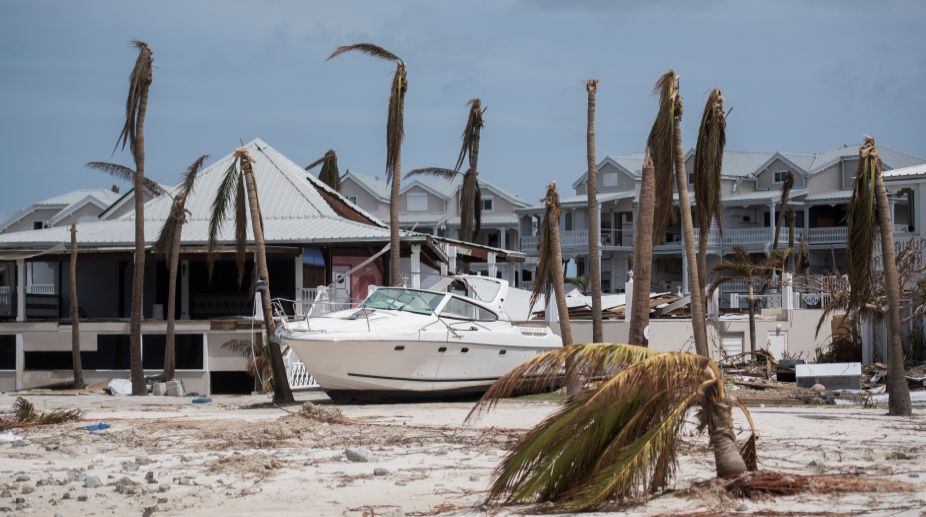80 ‘Paryavaran Sanrakshaks’ to become Delhi’s climate ambassadors: Sirsa
The main agenda of the project is to expand outreach efforts focused on sustainable lifestyles and understanding the impact of climate change.

(Photo: AFP)
The horrifying weather that has swept over the Atlantic is just a light example of things to come, according to researchers. The Americas have been hit by three destructive hurricanes in recent weeks —Harvey, Irma and then Jose. That is not simply a coincidence, say climate experts — instead, it is a demonstration of global warming in action.
Scientists have already warned that the response to the recent hurricanes shows how terrifyingly unprepared the world is for the kind of extreme weather events that will become more common as the Earth gets hotter. But they warn also that the combination of the hurricanes is a particular warning about the damage being done to the environment. What’s more, the weather effects that usually slowed the damage caused by such a run of hurricanes is likely to stop — meaning not simply that we will get more dangerous hurricanes, but they are more likely than ever to chain together in this way.
Advertisement
“Perhaps Harvey was happenstance and Irma could be coincidence,” said Philip Williamson, NERC Science Coordinator at University of East Anglia. “But Jose following close behind has to be climate change in action. Damaging hurricanes, cyclones and typhoons occur in tropical parts of the world, at the time of year when the sea is warmest. So if the world gets warmer still, the risk increases — it’s as simple as that.
Advertisement
“In particular, when one follows much the same track as another, soon afterwards, the second or third is usually likely to be weaker — since the surface will have been cooled by the initial mixing (bringing deeper, lower-temperature water to the surface). But that effect won’t happen, or will be much less, if there’s warm water at depth as well as in the uppermost layers. Here we see there has been some overlap of the ‘flight paths’ of Harvey, Irma and Jose, yet without resulting in any substantive reduction in their strengths, all being at least category 4.”
Climate experts are clear that the hurricanes themselves weren’t necessarily the result of climate change, and that while the combination of them is rare it could occur naturally. But environmental changes are making the strength and energy of such hurricanes far stronger, and allowing them to do far more damage.
“Climate change may not have caused Hurricane Irma but it is making its impacts a whole lot worse,” said Dave Reay, professor of carbon management at the University of Edinburgh.
“Rising sea levels and a warmer, wetter atmosphere are combining to intensify flood risks all around the world. President Trump said he withdrew the US from the Paris Climate Agreement to protect jobs and businesses. For many folk in Texas and Florida that decision must now be looking pretty short-sighted.”
As before, researchers have warned that the world is simply not equipped for the kinds of extreme weather that will come with changes in the environment. In particular, if the effects of such damage are spread differently across the world, meaning that people in poorer countries are far more likely to die, for instance. “The reach of extreme weather is spreading and its punch is getting stronger due to climate change,” said Jeffrey S Kargel from the department of hydrology and atmospheric sciences at the University of Arizona.
“No individual meteorological event is attributable exclusively to shifting climate, but human alteration of the atmosphere is having a major role in causing more costly and more frequent extreme weather events. Poor nations pay mostly in bodies, and wealthier, more developed nations pay more in damaged stuff but there comes a point when no amount of weatherproofing can protect people.”
(The independent)
Advertisement
The main agenda of the project is to expand outreach efforts focused on sustainable lifestyles and understanding the impact of climate change.
Terming climate change a “global challenge,” Vice President Jagdeep Dhankhar has emphasized the urgent need to protect India’s forests and agriculture, describing them as the “lungs and lifeline” of the country.
Rabindranath Tagore owes his conscience, consciousness and disillusionment to none but mother earth in the poem ‘Prithibi’, written on 16 October 1935. Around 1910, Tagore is writing the Santiniketan series of essays, and there, too, he underlines how he sees no distinction between his own self and the larger nonhuman around.
Advertisement
